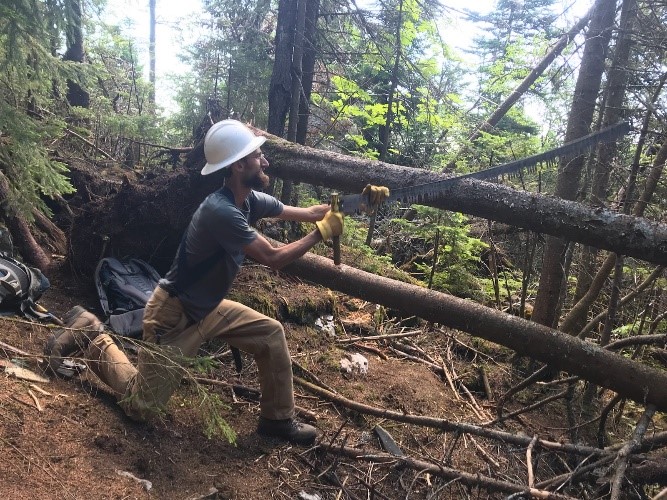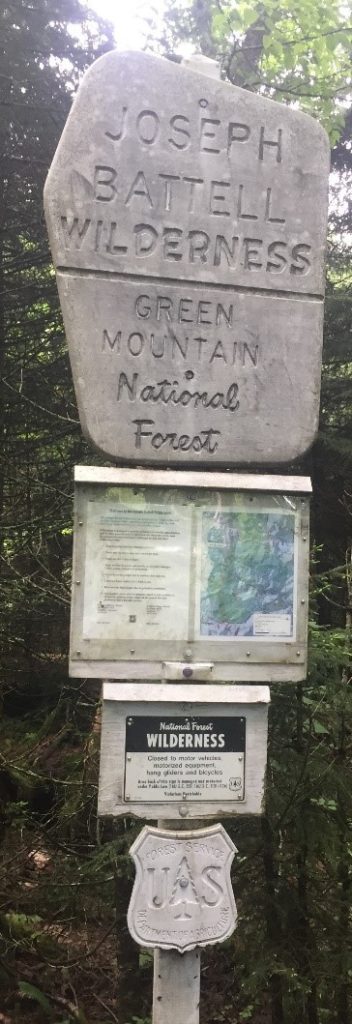
The Long Trail is lovingly described as a footpath in the wilderness but, technically speaking, just 45 miles of the trail are Wilderness.
The History of the Wilderness Act
The difference between wilderness and Wilderness, with a capital ‘W,’ came along on September 3, 1964, when the 88th Congress of the United States of America signed into law an act “To establish a National Wilderness Preservation System for the permanent good of the whole people, and for other purposes.”
Containing timeless and philosophical language (it’s worth reading, find it here), the Wilderness Act is a piece of critical legislation within America’s history of public land management. On that day in 1964, Congress made the decision to forever value areas of federal land which hold qualities intrinsic to the human spirit and fabric of our nation.
As recreationists, we tend to be more observant of our environs than even we may notice. While we may not acknowledge every time we hear a bird call in the canopy, see a mid-1800s stone wall, or stroll across a ridgeline with unaltered views into the adjacent valley, these features of the outdoors have an innate impact on the experience of the recreationist. Here are the five qualities of wilderness character from the Wilderness Act:
- Wilderness “…is an area where the earth and its community of life are untrammeled by man…” and “…generally appears to have been affected primarily by the forces of nature.”
- Wilderness “…is protected and managed so as to preserve its natural conditions.”
- Wilderness “…an area of undeveloped federal land…without permanent improvement or human habitation” and “…where man himself is a visitor who does not remain.”
- Wilderness “…has outstanding opportunities for solitude or a primitive and unconfined type of recreation.”
- Wilderness “…may also contain ecological, geological, or other features of scientific, educational, scenic, or historical value.”
By law, land managing agencies must preserve these five qualities within Wilderness areas. Originally designating 54 areas comprised of 9.1 million acres as Wilderness, since 1964 the National Wilderness Preservation System has grown to include 765 Wilderness areas totaling 109 million acres.
As a strategy to preserve these qualities across so much land, the Wilderness Act has defined 10 prohibited uses within Wilderness: commercial enterprise, temporary road, motorized equipment, landing of aircraft, structures, permanent road, use of motor vehicles, motorboats, mechanical transport, and installations.
Exceptions to the prohibited uses are allowed for in the following, Section 4(c):
“Except as specifically provided for in this Act, and subject to existing private rights, there shall be no commercial enterprise and no permanent road within any wilderness area designated by this Act and, except as necessary to meet minimum requirements for the administration of the area for the purpose of this Act (including measures required in emergencies involving the health and safety of persons within the area), there shall be no temporary road, no use of motor vehicles, motorized equipment or motorboats, no landing of aircraft, no other form of mechanical transport, and no structure or installation within any such area.”
Wilderness in Vermont
In Vermont, the Green Mountain National Forest manages nearly 100,000 acres of Wilderness. As stewards of a footpath in Wilderness, the Green Mountain Club was invited to participate in a Wilderness Awareness Training in March of 2018. Taught by the Arthur Carhart National Wilderness Training Center (ACNWTC), the two-day, 16-hour course is intended to increase interdisciplinary awareness of wilderness management responsibilities and enhance wilderness stewardship on the Green Mountain and Finger Lakes National Forest. The Long Trail is on the Green Mountain National Forest for approximately 150 miles, with about a third of that distance passing through 6 separate congressionally-designated Wilderness Areas. The Appalachian Trail, which the GMC manages for its time in Vermont, passes through a total of 26 Wilderness Areas en route from Georgia to Maine.

What’s different on those 45 miles?
 When the GMC and the Green Mountain National Forest make decisions about these miles of the Long Trail, they look to the Wilderness Act. Despite the Act’s detail, there is a lot of room for interpretation, especially because the Wilderness Act came along 54 years after the Long Trail. When faced with any prohibited uses, the GMC and the Green Mountain National Forest do as the Wilderness Act instructs, making an exception to the prohibited use in a way to meet only the minimum requirement which the Long Trail needs. Below are a few examples of a prohibited use and results of the Minimum Requirement Analysis.
When the GMC and the Green Mountain National Forest make decisions about these miles of the Long Trail, they look to the Wilderness Act. Despite the Act’s detail, there is a lot of room for interpretation, especially because the Wilderness Act came along 54 years after the Long Trail. When faced with any prohibited uses, the GMC and the Green Mountain National Forest do as the Wilderness Act instructs, making an exception to the prohibited use in a way to meet only the minimum requirement which the Long Trail needs. Below are a few examples of a prohibited use and results of the Minimum Requirement Analysis.
Structures: No new structures; maintenance allowed on existing shelters. For example, in 2016 when the GMC replaced the sill logs of Boyce Shelter within the Breadloaf Wilderness, all materials were carried in on the backs of staff and volunteers. To administer the Long Trail it was determined that there does exist a minimum requirement of trailside shelters. However, it was determined that the use of a helicopter to transport materials does not meet the Minimum Requirements Analysis in order to administer the Long Trail.
Commercial Enterprise: Allowed for in the form of outfitters, school orientation trips, and summer camps, for the purpose of enjoying the “benefits of an enduring resource of wilderness.”
Installations: Trail signs are installed less frequently and do not show mileage to the next trail destination. All signs are without paint or stains, left to weather naturally.
Motorized Equipment: We leave the loud and heavy chainsaw in the shed, instead carrying out a sharp axe and very sharp crosscut saw, quiet and lightweight primitive tools critical to maintenance within Wilderness. The Long Trail corridor itself is maintained to a different standard, with blowdowns left which may be easily climbed over and the trailside vegetation allowed to crowd the trail just a bit more.
Mechanical Transport & Landing of Aircraft: Generally used only for life-threatening emergencies or special situations interpreted by the land manager.
Your Land Ethic
Know Your Personal Wilderness Values
According to your personal values, consider the following questions:
- Is hunting an appropriate activity in Wilderness?
- Is it appropriate to interpret historic structures and cultural resources that are in Wilderness in a publicly available book?
- Should we be placing warning signs by natural caves in Wilderness that pose public safety hazards?
- Should a helicopter be used in Wilderness to rescue a person with a broken leg who is not in a life-threatening situation?
- Is it appropriate to allow a one or two-week window for chainsaw use to open trails after an intense blow-down event?
Take a moment the next time you enter one of the six Wilderness Areas on the Long Trail. Consider how in the last 54 years the soil has never felt the grip of an ATV or a feeding deer has never been scared off by a chainsaw. Generations of hikers have experienced the presence of an undeveloped pond in the boreal forest or the primitive challenge found in scaling a blowdown or engaging in a slightly frustrating search for the treadway. It’s almost as if that area has a certain character of wilderness.
This article was written by Lorne Currier, GMC Outreach & Field Coordinator.



















Thanks for this! We will share with the Bennington Area folks that hike and are newer to the idea of Wilderness (Bald Mt Trail).